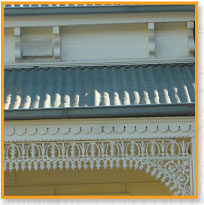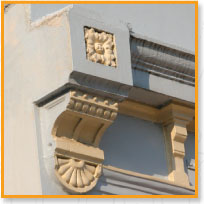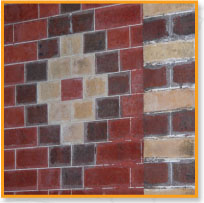
OUTSIDE: > walls sometimes multi coloured brickwork in decorative patterns or rendered, some bluestone construction > timber houses generally have square-edged weatherboards, sometimes with incised weatherboards simulating blocks of stonework > decorative brackets under eaves > windows generally timber double-hung, sometimes in tripartite format at the front |

|
GARDEN: > fences timber pickets, sometimes with more complex picket heads > for masonry buildings, fences commonly palisade-style with cast iron spears on stone plinths and ornamented end piers of stone, rendered or face brickwork, or cast iron > in large suburban gardens this period was dominated by the planting of conifers and evergreen trees > small gardens feature simple geometric layout |

|
INSIDE: > large and elaborate skirtings, architraves, cornices and ceiling roses > timber lining boards polished or painted > walls usually painted, plaster, or wallpaper over plaster > red and blue coloured glass beside entry doors
|

|
COLOUR & DESIGN NOTES: > external walls often left brown or red brick, with white or cream bricks at corners and openings > rendered walls left natural grey or sometimes lime-washed; timber houses painted to match stone colours > trims, roofs and verandahs use the same darker, stronger colours as Early Victorian style > interiors painted in bands of lower wall, upper wall, ceiling, with smaller strips of highlight colours on cornices
|

|
EXTERIOR COLOURS: |
||||
Salmon Pink |
Pink Beige |
Light Buff |
Light Stone |
|
DETAIL COLOURS: |
||||
Deep Indian Red |
Fawn |
Venetian Red |
Deep Brunswick |
|
HISTORY: > increased wealth from gold rush reflected in more ornate domestic architecture > Victoria’s population increases and a middle class emerges > local production of building materials increases with mechanisation > property developers construct rows of freestanding and terrace housing > Melbourne sprawls outwards along newly constructed train lines |
